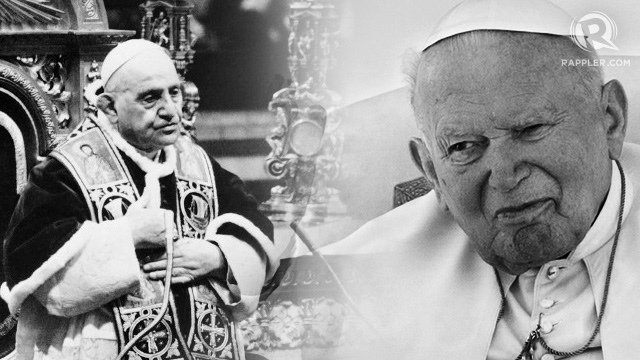SUMMARY
This is AI generated summarization, which may have errors. For context, always refer to the full article.

VATICAN CITY, Italy – Pope Francis has given the go-ahead for John Paul II to be made a saint and granted a rare exception for the canonization of another predecessor John XXIII, who had the same reformist views and personal touch as the current pontiff.
The announcements on Friday, July 5, marked a historic day at the Vatican, which also issued an unprecedented text co-written by Francis and his living predecessor Benedict XVI in which the two popes said faith was a “common good” and called for dialogue with non-believers.
The Vatican said Francis gave his widely expected formal approval to a second miracle attributed to John Paul II (1978-2005) at a meeting with Cardinal Angelo Amato, head of the Congregation for the Causes of Saints.
The supposed miracle occurred to a woman in Costa Rica, the Vatican said, following media reports that she had been cured of a serious brain condition by praying for the late pope’s intercession on the same day that he was beatified in 2011.
Popular pope
John Paul II (1978-2005) was hugely popular among Catholics through his 27-year papacy, and helped topple Communism although he alienated many with his conservative views and was blamed for hushing up multiple scandals over paedophile priests.
At his funeral in 2005, crowds of mourners cried “Santo Subito!” — which roughly translates as “Sainthood Now!” — prompting the Vatican to speed up the path to sainthood, which normally begins five years after the death of the person in question.
Poland welcomed the decision to make Polish pontiff John Paul II a saint.
Father Jozef Kloch, spokesman for the Polish episcopate, described the news as “an immense joy,” speaking on public radio.
“I think it’s marvellous news that will bring joy to all Christians,” Jesus Manuel, a Mexican monk, said in St Peter’s Square after learning the news.
Referring to John Paul II, Calogero, an Italian trainee priest, said: “In the hearts of the faithful he is already a saint.”
“The Church today is only confirming something that was already the case,” he said.
Dania, a Mexican tourist, said of John Paul: “He went everywhere in the world and wherever he went he helped people. I think it’s really good he’s being canonized.”
‘The Good Pope’
In the case of John XXIII (1958-1963), Francis “approved the favourable votes” from the Congregation for the canonization even though no second miracle has been found, in a break with the usual procedure.
The long road to sainthood normally requires two “confirmed” miracles, the first of which is necessary for beatification, a hurdle the Polish pope cleared just six months after his death.
That was the healing of a French nun, Sister Marie Simon-Pierre, whose recovery from Parkinson’s disease after praying for the late John Paul II’s intercession apparently had no medical explanation.
The announcement on John XXIII was greeted with bells ringing out in a parish church in the village of Sotto Il Monte in northern Italy where he came from.
A consistory, a meeting of cardinals, will now be held to determine the exact date for the canonizations but Vatican spokesman Federico Lombardi said they would take place “before the end of the year.”
Nicknamed “The Good Pope”, John XXIII made his name by calling the historic Second Vatican Council (1962-1965) which overhauled and modernized the Catholic Church’s rituals and doctrines.
Reformist pope
Francis also promises to be a reformist pope, planning an overhaul of the Vatican bureaucracy and its finances and promising a “poor Church for the poor”.
The current head of the Roman Catholic Church is often compared to John XXIII for his pastoral attitude, which contrasts with the more austere and academic style of Benedict XVI.
A religious text issued by the Vatican on Friday, however, showed that behind the differences in style there was continuity between Benedict and Francis.
The encyclical was co-written by the two men — a first in Church history — and highlights the importance of faith in modern society, as well as restating the Vatican’s opposition to same-sex marriage.
It also said faith cannot be “imposed by force” and believers should not be “presumptuous.”
Francis and Benedict, who both live within the walls of the Vatican City and wear the white papal vestments, met publicly on Friday at a ceremony in the Vatican for the unveiling of a new statue.
Benedict shocked the world in February when he became the first pope to resign of his own free will in 700 years of Church history.
Francis was elected by a conclave of cardinals to succeed him in March, becoming the first non-European pope in nearly 1,300 years. – Rappler.com
Add a comment
How does this make you feel?
There are no comments yet. Add your comment to start the conversation.